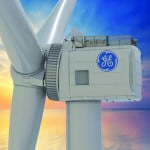GE has announced it will integrate its renewables, grid, and energy storage assets into a simplified, single business that nearly doubles the size of its Renewable Energy division, as the company banks on the accelerated uptake of grid-connected renewables worldwide.
The expansion will see GE’s grid solutions, solar solutions, and storage businesses move from GE Power to GE Renewable Energy. The company also said it will regionalize its onshore wind business to simplify and make that business more “local.”
The company’s freshest business reshuffle was announced a day before GE is expected to report its earnings for the fourth quarter of 2018. The industrial conglomerate has suffered a series of financial ups and downs over the past year, owing in part to weaknesses in the power segment.
A Mass Consolidation
The company—long a formidable leader in the gas turbine business—has been struggling since its $10.6 billion acquisition of Alstom’s Power and Grid business in 2015. Last November, GE announced the reorganization of its Power division into two businesses, forming GE Gas Power, comprised of Gas Power Systems and Power Services, and GE Power Portfolio, comprised of the Steam, Grid Solutions, Nuclear, and Power Conversion businesses. In a December interview with POWER, newly appointed GE Gas Power CEO Scott Strazik acknowledged that renewable energy will continue to grow “exponentially,” but he also offered optimism about the growth of the company’s natural gas business.
GE Renewable Energy CEO Jerome Pecresse, who created Alstom’s Renewable Power business—a division that had close to 10,000 employees when it was absorbed into GE—told reporters in a Jan. 30 call that the renewables and grid consolidation would create a $16 billion business with 40,000 employees. GE’s Renewable Energy division now employs about 23,000 workers, he said. As of the end of 2017, GE had a total 313,000 employees, about 83,500 of which were affiliated with the Power division.
It will mean that GE Renewable Energy, which has so far housed the company’s onshore wind, offshore wind, LM Wind Power, and hydro offerings, will now also oversee its grid solutions and hybrid renewables technologies, which were previously part of the Power division. That will leave GE Power’s portfolio with the steam, nuclear, and power conversion businesses. A GE spokesperson told POWER that GE does not plan to dispose of any businesses as a result of this announcement.
As significant is GE Renewable Energy’s efforts to streamline its onshore wind businesses to improve competitiveness and speed of project installation through local execution. The company plans to eliminate the onshore wind “headquarters layer,” and will instead elevate its current regional teams. The teams will be focused on the Americas, Europe/Africa, the Middle East and North Africa, and Asia-Pacific. “We are basically transitioning to an organization that is going to be more reactive, close up to customers, and transferring more decision power to the regions,” Pecresse said.
The company also moved to establish a global wind service unit with profit and loss (P&L) responsibilities, which will encapsulate all onshore, offshore, and blade activity into one team.
A Bigger but More Accessible Business
The streamlined approach, Pecresse said, would reap benefits for all GE Renewable Energy’s segments in a market that has grown ever more competitive. Market-driven initiatives to bring down costs is “affecting all parts of the value chain—from the turbine, to the storage, to the PV components, to the grid,” he noted. But even with the virtual doubling of its renewables business, GE’s goals wouldn’t change, he said, and the company will continue to strive to boost performance through technology and working to bring down product costs. An integration of solutions will also make the business more capable of supporting customers holistically, from project development, to helping them choose equipment and services, or opt for full turnkey solutions.
Consolidation of renewables and storage could also specifically boost GE’s marked efforts to penetrate the growing global energy storage market, Pecresse noted. Over the past year, GE has made progress in the storage market by developing the “right technical solutions for the storage market,” that focus on market needs such as short-term storage duration and black-start requirements. “By taking this business on board with [GE Renewable Energy], we want to do two things: One, to continue to accelerate the roles of technical [and commercial efforts], and second, we want to go faster on the kind of typical storage applications, which make sense for our renewable customers,” he said.
GE’s emphasis on its renewables division has been building for some years, and the move may not come as a surprise to some. In its third-quarter 2018 earnings statement, GE Renewable Energy said that “steady growth continues” in the sector. It posted sales of $2.9 billion—a 15% increase from last year—and reported orders worth $2.9 billion, including a 61% year-over-year increase for onshore wind service orders. Pecresse then noted: “According to financial analysts, by 2020, renewables will have become the cheapest form of power generation. It is estimated that the price for renewable energy will drop by ~4% each year from 2019-2021. Those kinds of continuing efficiencies will enable green power to become the primary, mainstream power source for people everywhere over the next 20-40 years.”
Asked on Wednesday why the company was expanding its renewables division now—though industry projections have forecast soaring renewables growth for years—Pecresse said: “I think probably because there is a recognition of the interconnection between renewable dynamics and grid dynamics.” The decision comes on the heels of GE’s efforts to establish a Gas Power business distinct from its Power division, he noted.
—Sonal Patel is a POWER associate editor (@sonalcpatel, @POWERmagazine).









